One thing I always try to make time for when I visit Egypt is a boat ride on the Nile at Aswan. Many Nile cruise itineraries either begin or end at Aswan, so I’d recommend arriving either a day early or staying a day late to allow time for this opportunity to enjoy a scenic, peaceful, beautiful experience.
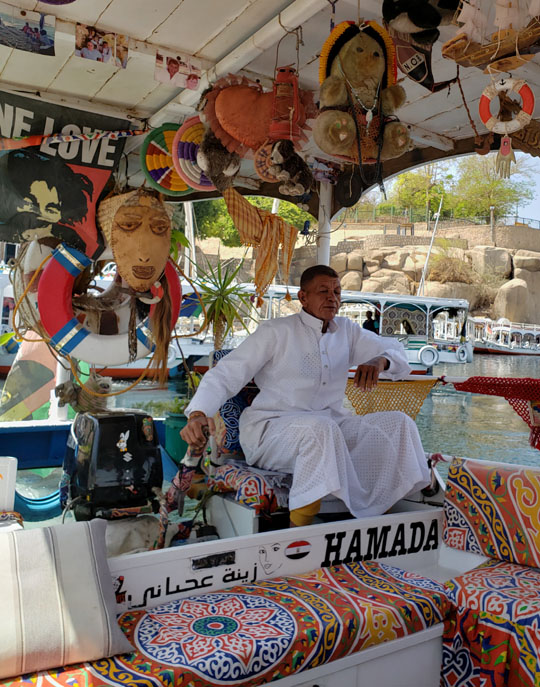
My favorite boat captain to use for cruising the Nile River at Aswan is Captain Karim. He expertly guides the boat along the Nile, offering close-up views to the many sights along the way, and he speaks enough English to answer questions. If you ask, he’ll play a radio station with Nubian music.
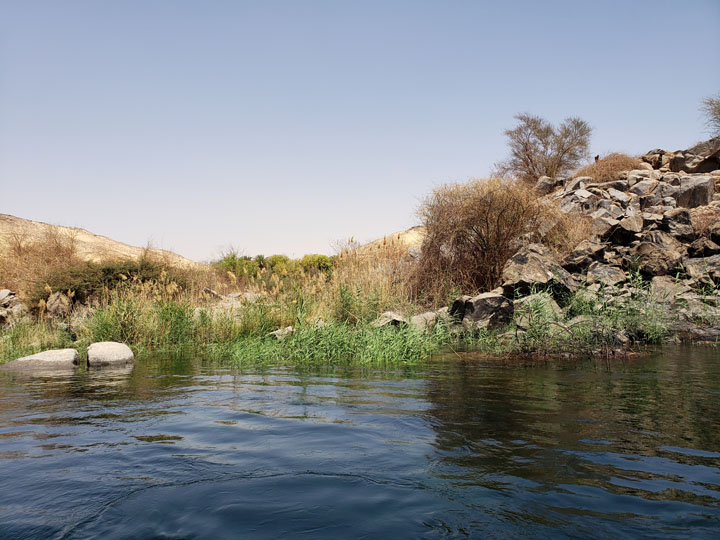
There are many scenic views along the Nile River, and this is exactly why I have done this many times. After spending time in the urban, high-energy environment of Cairo, I look forward to coming closer to nature when I get to Aswan.
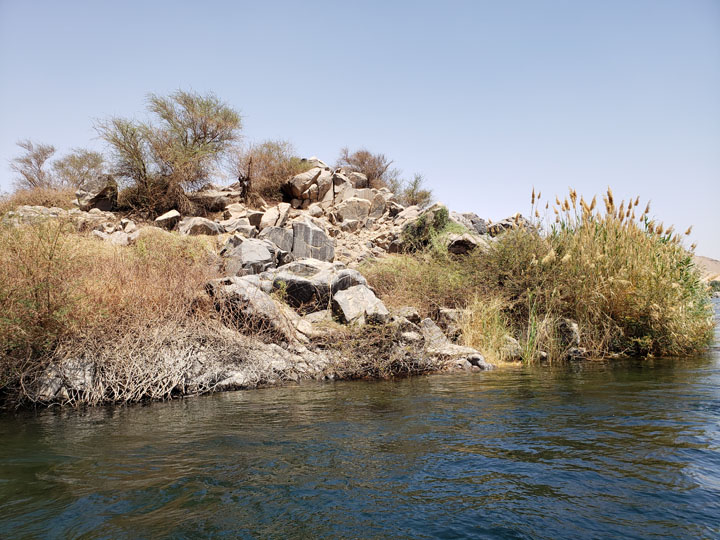
There are two different types of boating experiences you can use to experience the Nile scenery at Aswan. One is a ferry boat, which is what I was riding at the time I took these photos. The ferry has an engine which is silent enough that it doesn’t detract from the peaceful beauty of the ride. The other is a felucca, which is an Egyptian style of sailboat.
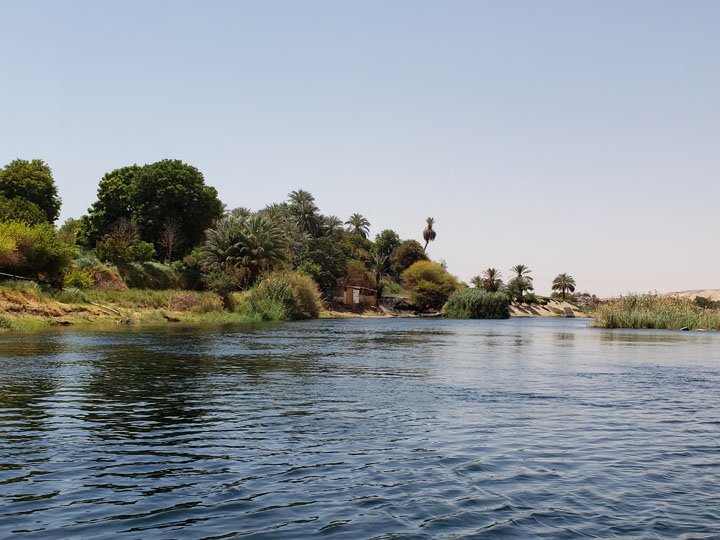
Sometimes young boys on a small raft will paddle out to meet your boat. These young buskers sing to you, hoping you will tip them for the entertainment they provide.
I personally enjoy the boys, so when I see them approach, I’m inclined to give them an Egyptian five-pound note. I used to give them just one pound, but Egypt’s economy has experienced significant inflation since 2011’s revolution, so I tip in higher amounts now than I did in 2010. You may be wondering what songs they use to serenade you. The ones I’ve heard the most are “Row Row Row Your Boat” and “Frère Jacques”.
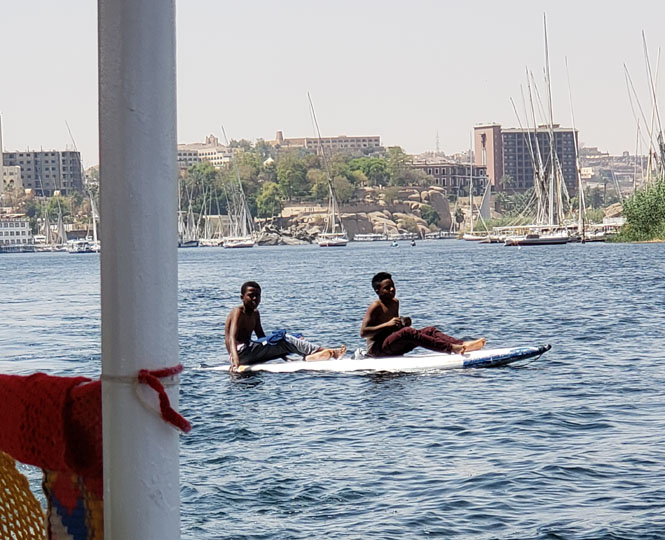
One of the landmarks you’ll see on the western bank of the Nile River at Aswan is the steep hill containing Aswan’s Valley of the Nobles. High on the top of that hill is a structure known as Qubbet el-Hawa, the Dome of the Wind, which marks the tomb of a long-ago Islamic sheikh named Aly Abu el-Hawa. I have also heard people refer to this structure as the watchtower because of the expansive view it offers of the Nile valley. The entire mountain is also sometimes referred to as Qubbet al-Hawa, encompassing the Pharaonic tombs in addition to el-Hawa’s tomb.
I have personally never climbed this mountain to explore its sights. There is no road that a taxi or tour bus could use to take you there. The only way to approach it is from docking the boat on the bank of the Nile River at the bottom of the hill. From there, you can either ride a camel up the hill, or you can hike up. If you want to use a camel, it’s best to prearrange for that, because there often are not any camels waiting at the bottom.
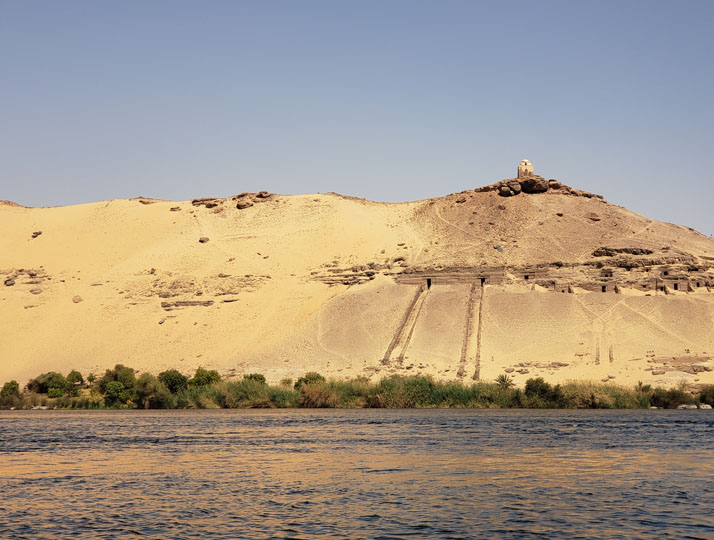
Another hillside on the west bank of the Nile at Aswan features the Mausoleum of the Aga Khan III, Sir Sultan Mohammed Shah, the 48th Imam of Nizari Ismailis. He was born in the city of Karachi, which lies in modern-day Pakistan, and he assumed his title of Aga Khan at age eight, after his father died. His tomb was built in the style of the historic Fatimid tombs that can be seen in Cairo today.
Although the Aga Khan was from Pakistan, Egypt held a special place in his heart because it was there that he met his French wife, Yvette Blanche Labrousse. She took on the name Begum Oum Habiba after they were married. Below the Mausoleum, behind the trees in this photo, is the villa where the Aga Khan and his family spent their time when they came to Egypt for visits.
Locals report that after he died, the Aga Khan’s fourth and final wife used to visit his tomb in the Mausoleum every day and lay a red rose on his grave. When she died in 2000, she was laid to rest next to him.
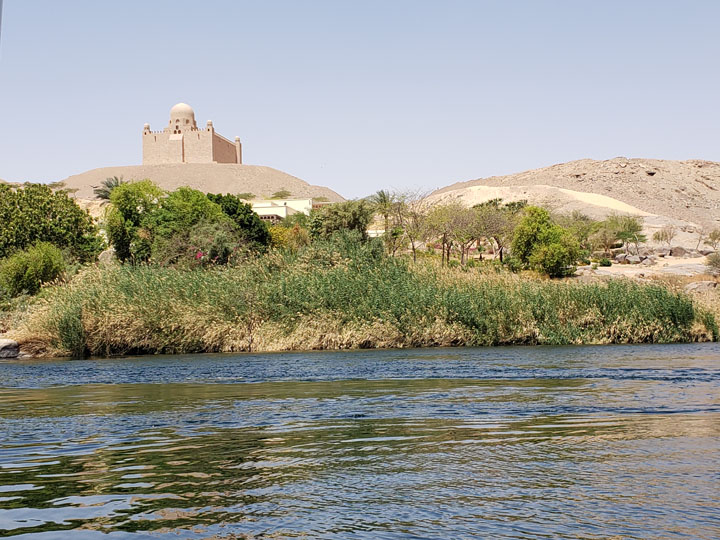
On another hillside, a historic monastery looks down on the Nile. This monastery, which dates back to the 7th century, was originally dedicated to a local saint named Anba Hedra who renounced the world on his wedding day. It has also been known as Deir Anba Sim’an. In the 10th century, it was dedicated to Saint Simeon. In the past, it housed about 300 monks. The troops of Salah ed-Din (Saladin) partially destroyed this facility in 1173.
There are no roads for vehicles leading to this monastery. If you want to visit it, you’ll need to ride a boat across the Nile. Once across, you can either walk up the hill yourself or hire a camel to carry you. If you plan to use a camel, I’d recommend prearranging it. This area does not always have camels sitting around waiting for something to do.
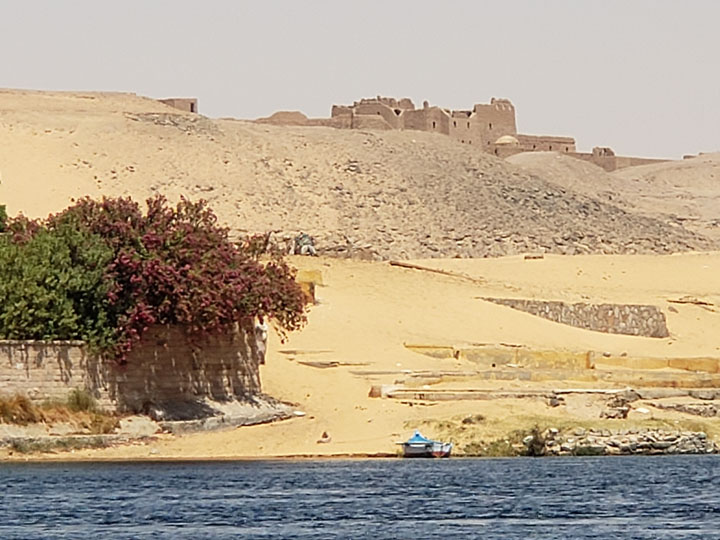
Before the Aswan High Dam was built, the west bank of the Nile River at Aswan was mostly uninhabited because of the annual inundation by the river. As a result of the dam being built, the inundations ended, while south of the dam Lake Nasser arose, flooding the homeland where thousands of Nubian people had lived since ancient times. Reports vary on how many Nubian people were displaced by the rising lake, with estimates ranging from 40,000 to 100,000. With the inundations ending north of the dam, some of the Nubian people whose ancestral homes now lie under the waters of Lake Nasser have started to develop a community on the west bank of the Nile at Aswan.
A village named Gharb Sahel has arisen, with homes, hotels, shops, and more. The Nubians who live there have preserved their traditional architectural style, which is highly effective at encouraging ventilation and insulating against the heat.
It is possible to book a tour of one of the Nubian homes in the village. There are several who are willing to show visitors their architecture and talk about their lifestyles.
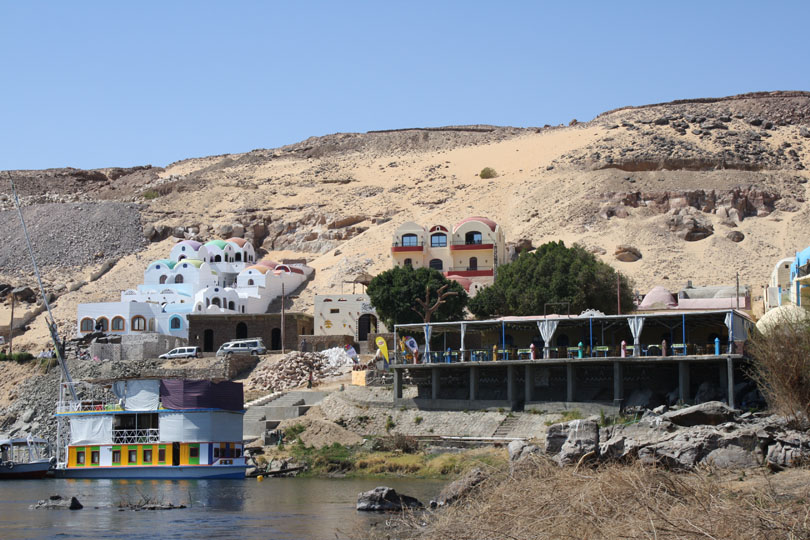
I have found these tours of Nubian homes to be a highlight of my time in Aswan because of the opportunity to learn more about the culture. The photo below shows the ornaments that dangle from the ceiling and the table with items for sale. The cool cat modeling the sunglasses is the ferry boat captain who transported us there, Captain Karim.
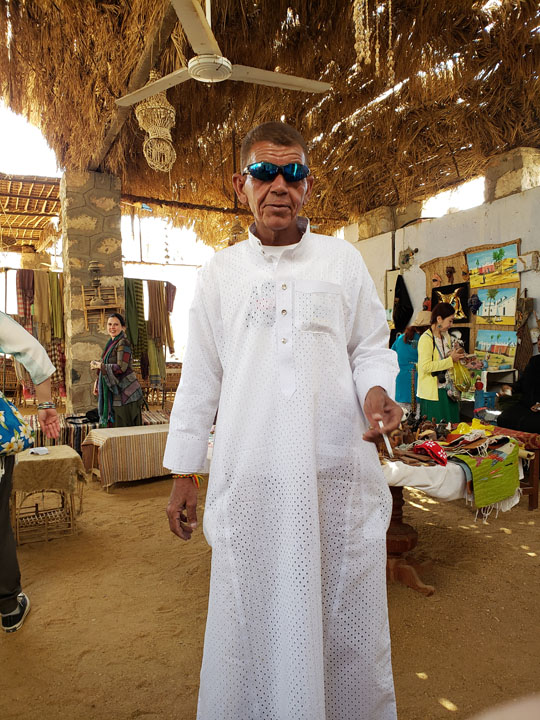
After visiting Gharb Sahel, the return trip on the boat offers additional scenic views along the Nile.
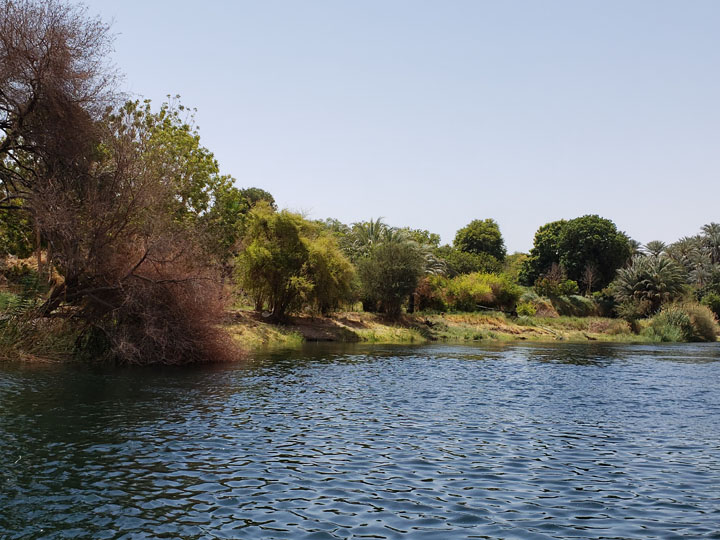
El Nabatat Island, also known as Kitchener’s Island, is a popular tourist destination because it hosts the Aswan Botanical Garden. Today, the island is owned by the Egyptian government and is used as a botanical research station. It is possible to arrange a boat ride to the island and walk through the garden. I have not personally done this, but it’s on my wish list for a future trip to Egypt.
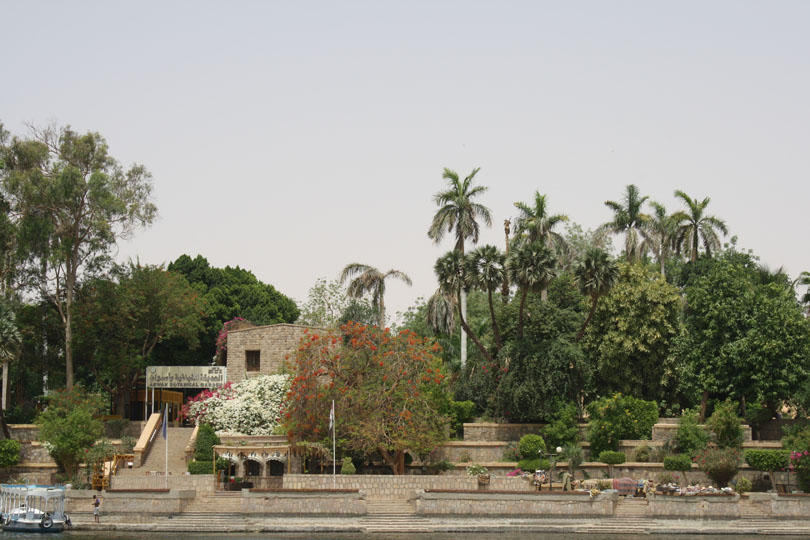
Elephantine Island’s history dates back to Pharaonic times, when it was the southern outpost of Upper Egypt, on the border of Kush (Nubia). The book River God by Wilbur Smith sets some of its action on this island. One of the items on my wish list for a future visit to Aswan is to visit what’s left of this archaeology site today. A boat can take you close to its Nilometer for a closeup view, as shown in my photo below. See my article about Nilometers for more information about this and others.
Today, a hideous, soulless Movenpick Hotel crouches on Elephantine Island, a blight on the scenic landscape of the Nile. I hate the sight of this eyesore so much that I’m not including a photo in this blog post.
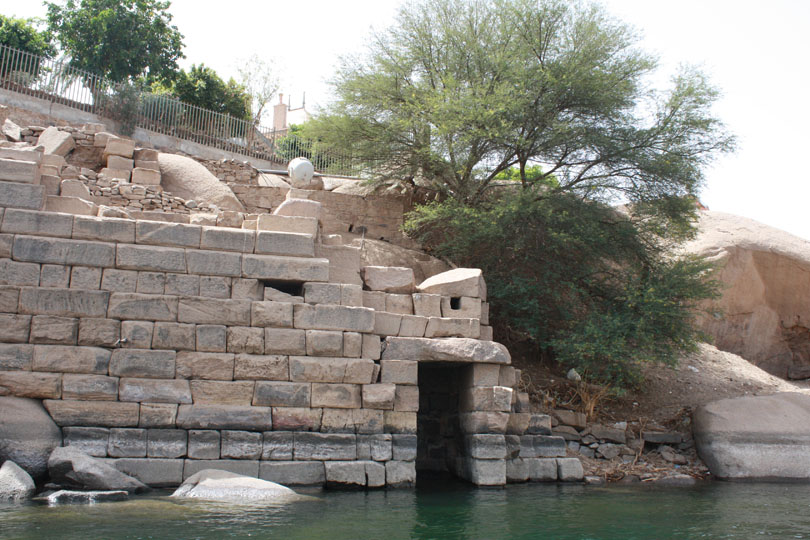
In ancient times, Aswan’s population included a large number of ethnic Nubians, and still does today. With the Kush empire (also Nubians) immediately to the south, it was important to the Egyptian Pharaohs who were based in Luxor to ensure that Aswan was governed by someone who was capable of maintaining the respect and loyalty of the Nubian locals. For that reason, many of the governors in Aswan over the centuries were ethnic Nubian. Queen Nefertari, who was honored by the temple at Abu Simbel and the spectacular tomb in Valley of the Queens at Luxor was a Nubian princess whose father governed Aswan.
Because of Aswan’s position on the southern border of Egypt’s Pharaonic empire, some boulders along the river feature cartouches that declare Egypt’s claim on this location, as shown in the photo below.
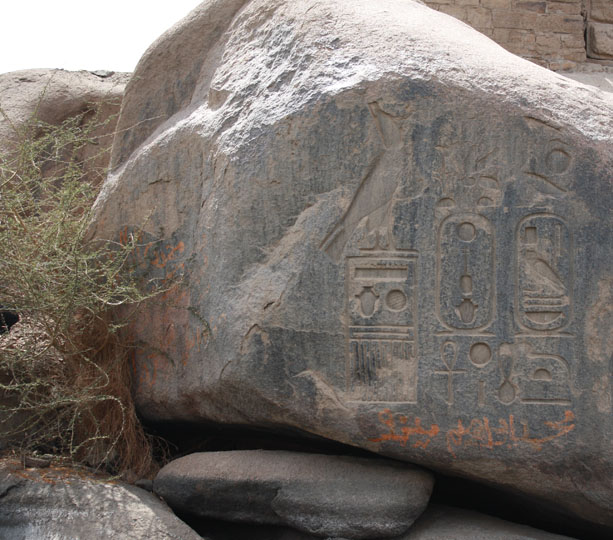
A popular Egyptian pop singer and actor named Mohamed Mounir has built a mansion on the banks of the Nile near Aswan, and it is possible to see it from a ferry boat or felucca. The mansion is the domed building in the foreground of the photo below. Many of Mounir’s fans refer to him as “The King”.
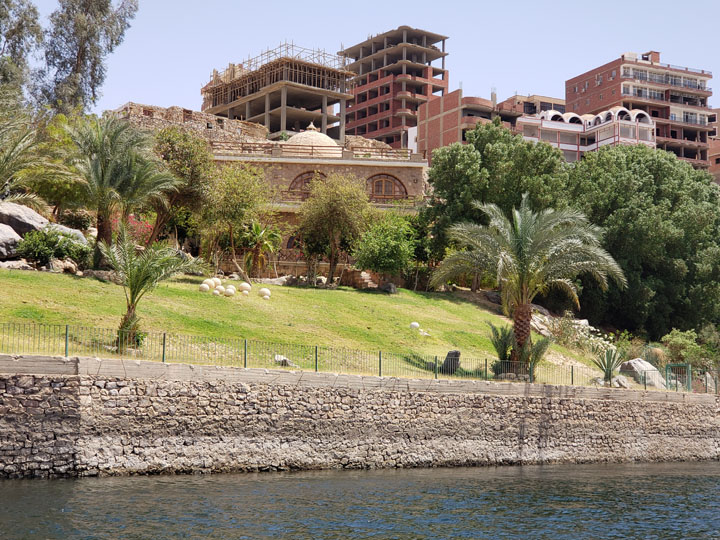
Closing Thoughts
When we travel, it can be very tempting to cram our schedules full of every imaginable activity, every day. This can lead to burnout by the end of a vacation. I find that the ferry ride on the Nile helps me replenish my energy. It allows me to spend time in nature, on the river, and it allows me to forget for a while about the frantic schedule that tours often provide. There’s something fulfilling about being out on the water, simply enjoying the beautiful scenery.
Other Blog Posts About Aswan, Egypt
If you enjoyed this post, you might enjoy these others posts I’ve made about Aswan, Egypt:
-
- Honoring Motherhood in Ancient Egypt’s Temples and Tombs. This one includes Philae as one of the temples it talks about.
- Aswan, Egypt: The Mystery of the Ostrich Egg. An interesting item displayed in the Nubian Museum at Aswan.
- What It’s Like to be in a Sandstorm in Egypt. Includes a photo of a sandstorm I experienced in Aswan.
- Exploring Nilometers in Egypt. Includes the one on Elephantine Island, which I included a photo of above.
- Fellaha: The Peasant Woman in Egyptian Art. Includes a statue of a fellaha at the Basma Hotel in Aswan.
I too, have sailed from Aswan to Luxor in a felucca (3 days) with only foam to sit, eat, sleep (’92). Our captain’s name was Ramadan. I remember when we had to pee, etc. they used a li’l wooden ramp to get onto the banks. We had to watch out for crocodiles and burn the toilet paper. We also swam a bit in the middle, but needed to hold onto the rope, so I guess you could say we “wiggled” in the water. I also loved the sound of minarets in the background. We took a bus to Abu Simbel (from somewhere) that left at 3am. It was an adventurous trip, I’ll never forget. Thanks.
I am pkaning a visit to Egypt. Any recomendation for tour guide.
It depends on where you’re going in Egypt. In Cairo, I like Nibal Abdel Aziz. In Luxor, I like Ayman Abounaga (you can book him through Gezira Garden Hotel, which is where I like to stay in Luxor when I go there). In Aswan, I like Wael Mohamed Ali. You can find all three of them via Facebook.